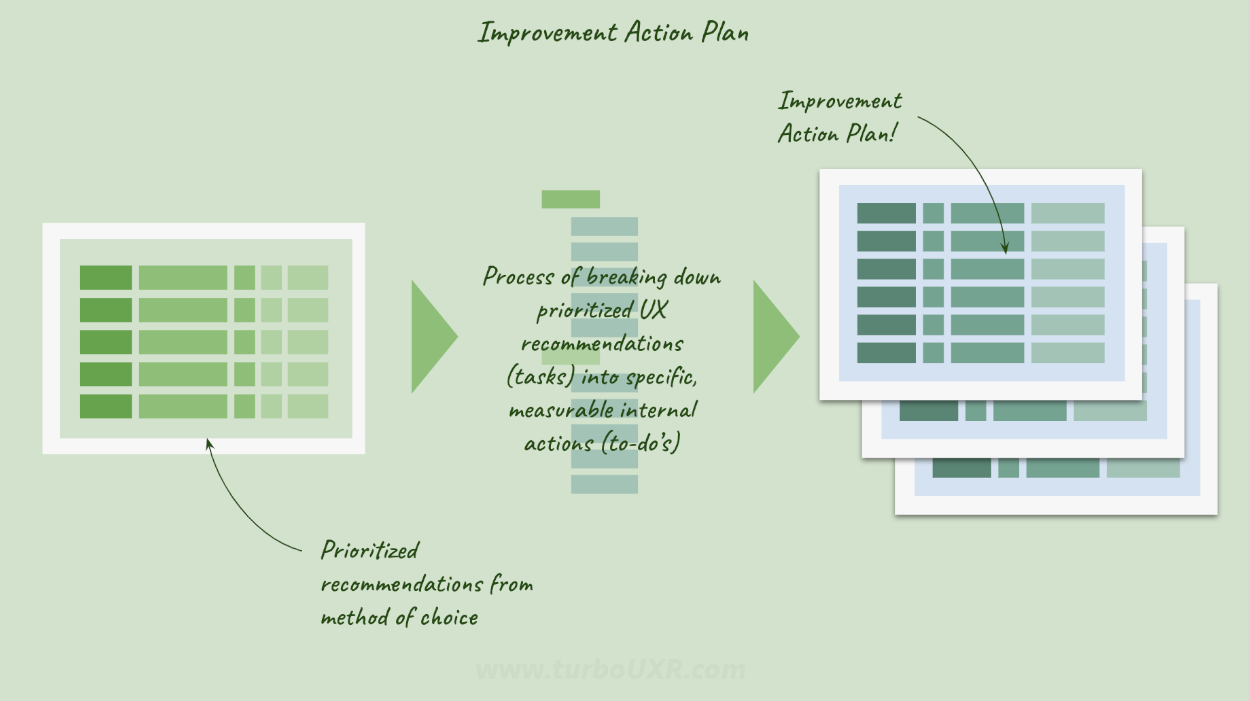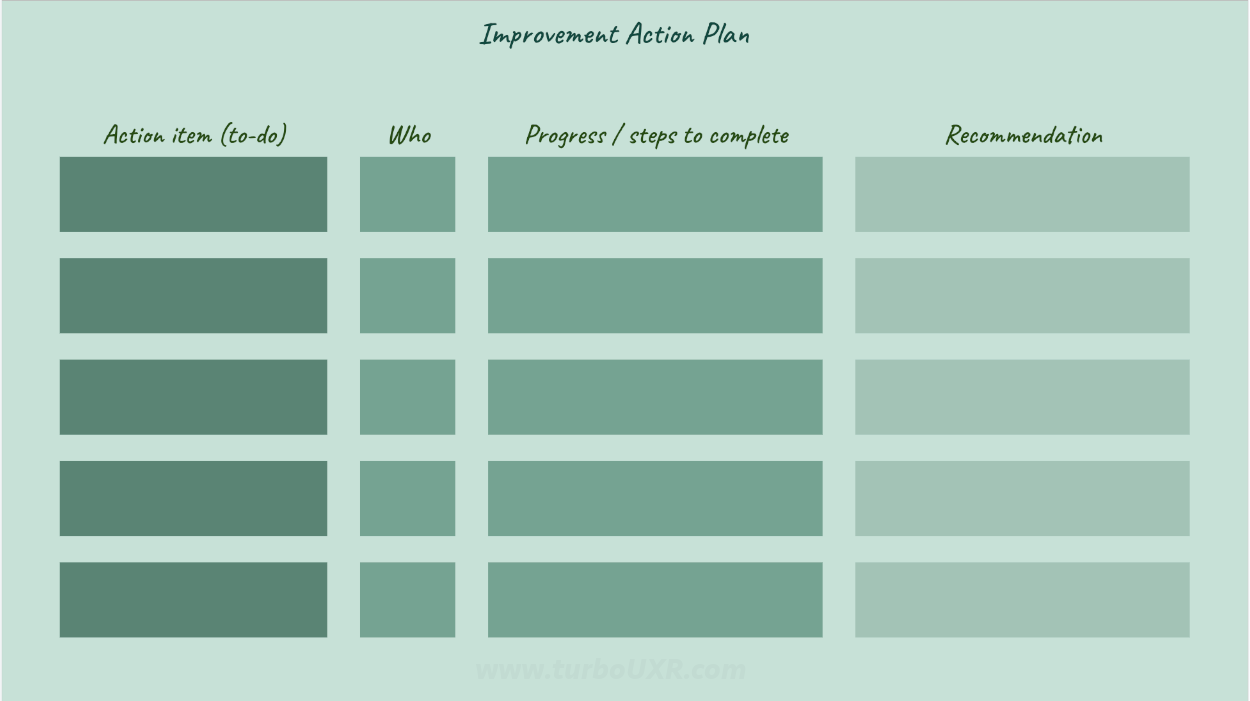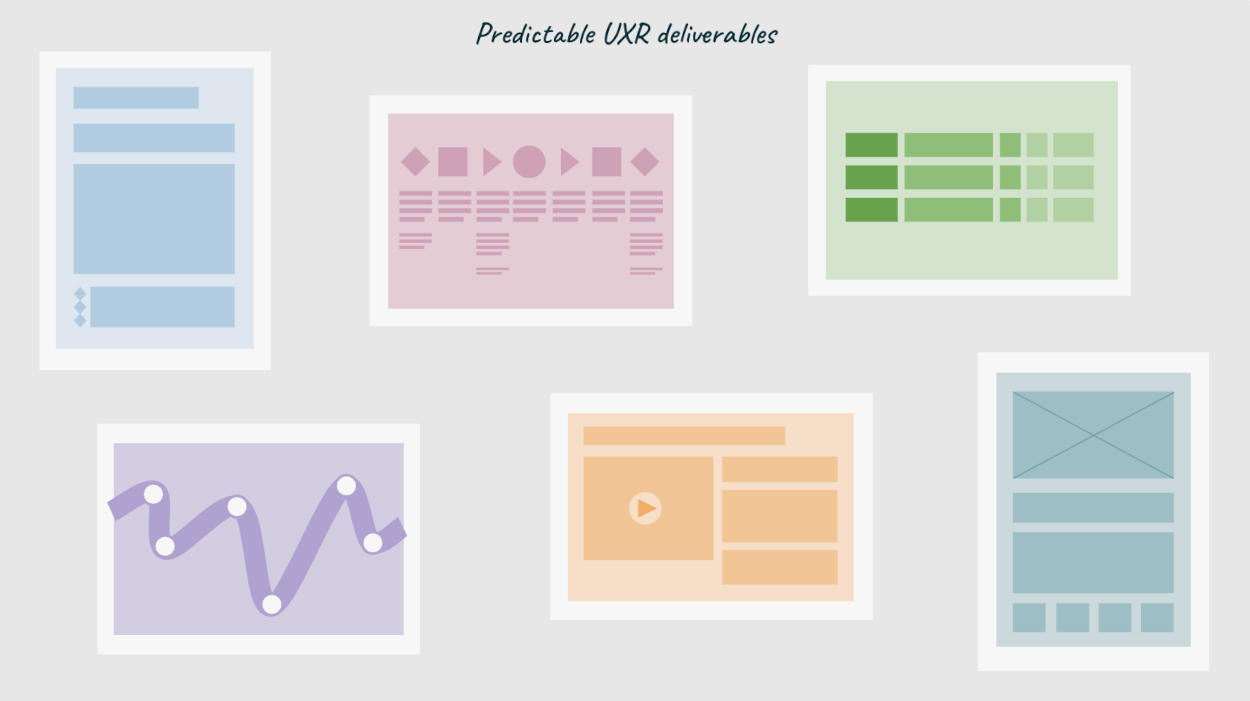Need user insights? Get the Playbook 📕
Ready? Set. Action! We've made it to the starting line for UX improvements. Seems like a lot of steps just to get to the beginning of implementation. Well, that's the way it is. All UX research accomplished up until this point was the pre-work to make real, tangible changes to the user experience.
Work smarter, not harder.
The Turbo UXR Playbook is your tactical reference 👇 guide — free to download!
Get the Playbook
Learn More
So far, we've succeeded in figuring out how to craft user stories that summarize key insights, we've tailored our optimal approach to user insight storytelling for enhanced stakeholder comprehension, and we've decided on the best way to prioritize UX recommendations for increased adoption. Now, the real work is just beginning — UX improvements.
Improvement Action Plans are technically the end-of-the-line as far as individual UX research projects go. From this point onward, partner stakeholders will carry the torch. They'll be the ones implementing the changes to the actual product strategy, development code, copy & content, marketing materials, UX/UI designs, and more. The UX Improvement Action Plan is the tool of choice for getting that process kickstarted 🚀.
In this article, you'll learn about what's a UX Improvement Plan, where actions (to-do's) originate, 4 components that make them up, how this process fits into the overall UX research scope of activities, and templates to assist. We're excited you've gotten to this significant milestone. It's time to fully empower stakeholders to take action 🎬 on the UX improvements identified from UXR. Let's pave the way.
user experience enhancements uxd improvements ux research operations UXR-OPS ux action plans uxr project management measuring ux research quantifiable uxr impacts
An Improvement Action Plan is a tool that breaks down the prioritized UX recommendations (tasks) into specific, measurable actions (to-do's) to be tackled by the organization.
In our last article, 5 methods of Prioritizing UX Recommendations 🤓, we learned how to rank and sort recommendations into hierarchy of importance. The purpose is to identify the most valuable recommendations to tackle. This prioritization process establishes the ordered list of major tasks to accomplish. Examples look like: 'Do [X]', 'Change [Y]', 'Consider [Z]' to solve for [User Need].
An Improvement Action Plan (IAP) double-clicks on the ordered list of tasks. IAPs outline all of the specific actions necessary to accomplish each task. Another way of thinking about actions, is they're organizational to-do's. Essentially, the process is creating a cross-functional to-do list to make sure UX recommendations are seen through to completion. A to-do list that's specific and measurable. Because — often times — if you don't do this, it ain't gonna get done.
Work smarter, not harder.
The Turbo UXR Playbook is your tactical reference 👇 guide — free to download!
Get the Playbook
Learn More
Improvement Action Plans make things stupid simple. The measurable nature of the to-do's allow for project managers to easily delegate the work to appropriate parties. Therefore, you don't have to be there 🎉. You can move on to other pressing UX research work in various stages (planning, analysis, synthesis, etc.). But where do these actions originate?

The to-do list within the Improvement Action Plans can be tied all the way back to the original user insights. That's the beauty of the TurboUXR process. There's clear documentation from beginning to end. Each of the 11 processes within the research system of operations flow from one to the next. At the beginning, there's the user insights. At the end, there's the UX Improvement Action Plan.
Insights ➡ Insight Theme ➡ User Story ➡ UX Recommendations ➡ Prioritized Recommendations (tasks) ➡ Improvement Actions Items (to-do's).
Invariably, an assortment of research activities will generate the raw user data. That data is analyzed through various methods to churn out insights. Many related insights are synthesized into Insight Themes. Insight Themes produce a User Story and related UX recommendations. Prioritization of the recommendations, leads to the list of ordered tasks. And the final job of the Improvement Action Plan is to break down these tasks into tactical to-do's 🔧.

An Improvement Action Plan can be as simple as a spreadsheet. First, import all the prioritized recommendations, or start a new tab within your existing prioritization spreadsheet. Then, break down the highest priority UX recommendations into very specific, measurable tasks.
The reason for being specific is to make certain the work gets done, and doesn't confuse stakeholders along the way. Measurable 📈 is necessary to quantify progress, and track impact for the organization.
What exactly needs to get done? Action items are individual to-do's that are specific and measurable. They expressly detail all of the internal, cross-functional work necessary to accomplish a larger task 📝. For example, action items from our previous work include: "Devise 3 options for new copy that increase user positivity", "Develop A/B test parameters to quantify design decisions", "Update code to remove interstitial pages by April 10th". Typically, 3–10 action items are produced for each UX recommendation. Lastly, utilize dates, numbers, and percentages within each — where possible — to ensure measurability.
Return to overview ⤴Who is going to lead the work? Designating a point-person for each action item establishes ownership. Without someone on the hook 🪝, the work tends to fall to the wayside. Therefore, always make sure there's at least one stakeholder identified who'll be accountable. This very well might be a lead from Design, Product, Ops, Eng, Marketing, or you!
Return to overview ⤴What are the sub-steps to completion? Have the lead stakeholder help to make a bullet-point list of the sub-steps necessary to complete each action item. Outline the major checkpoints ✔️ and work to be done. By doing this, you'll help the team establish a sense of progress. Even better, have the project manager cross them off as the work gets done. This will increase project clarity as you manage both up, and down.
Return to overview ⤴To which UX recommendation does this align? Lastly, indicate for which UX recommendation this action item is solving. This will help with tracking from where work came, and how it backtracks 👣 all the way to the end-users' needs. Each action item points to its respective UX recommendation. That UX recommendation points to the associated User Story. And that User Story lives within the Insight Theme which highlights the original user insights, quotes, and video. All-in-all, anyone can easily see how each action item ties back to the original user-centered insights and opportunities.
Return to overview ⤴
The process of planning actions for UX improvements exists within the Implementation phase of a UXR project. As we just learned, the Implementation phase is all about making real changes come to life.
This phase is truly critical in terms of follow-through. Last does not mean least. Recommendations lead you to actions, and actions lead you to changes / testing of the user experience. Without seeing these processes through to the end, your research will not have the significant impacts necessary to keep a UXR job on the long-term. Ultimately, a UXRr needs to show tangible results and improved metrics as a result of UXR. So, get to action!
See our End-to-end UX Research Project Guide to learn more about the additional phases that prelude Implementation.

Need help getting started? Check out our online repository of user experience research templates. This UXR toolbox has specific templates for all phases of a UX research project. Examples include a UXR project brief template to get research projects started on the right foot, a user insight theme presentation document to deliver actionable insights and recommendations to Product teams, and relatedly a UX Recommendation Prioritization + Action Plan framework for increasing Product adoption and action.
Looking for other UXR templates and tools? We've got more, but they might not be published yet. Reach out to us @TurboUXR to start a conversation about which UX research ops process you're looking for guidance. We'd be happy to tailor a template or work with you to create something wholly new ✨.
Back to top ⤴
Work smarter, not harder.
The Turbo UXR Playbook is your tactical reference 👇 guide — free to download!
Get the Playbook
Learn More